Novel PEV Charging Approaches for Extending Transformer Life
Abstract
:1. Introduction
- How can vehicle charging be enhanced by creating chargers that can deliver variable rates?
- If plug-in electric vehicle charging is enhanced by creating chargers that can deliver variable rates, is it limited to uncontrolled or controlled strategies?
- Does the method that a smart charger utilizes deliver variable rates to a vehicle significantly affect how well the algorithm can reduce transformer overloading?
- Can variable-rate uncontrolled PEV charging reduce transformer overloading better than fixed-rate controlled PEV charging?
- If variable-rate controlled PEV charging does not perform significantly better than fixed-rate controlled PEV charging, what is an optimal fixed-rate that should be adopted?
2. Materials and Methods
2.1. Problem Formulation
2.2. Selected Rate Valley-Filling Methodolgy
2.3. Rate Interval Valley-Filling Methodolgy
2.4. Transformer Data
2.5. Transformer Data
- Commute distances
- Commute times
- Vehicle charging needs
- Travel time distribution
- Vehicle model type distribution
3. Results and Discussion
4. Conclusions
Author Contributions
Funding
Institutional Review Board Statement
Informed Consent Statement
Data Availability Statement
Conflicts of Interest
References
- Van Triel, F.; Lipman, T.E. Modeling the Future California Electricity Grid and Renewable Energy Integration with Electric Vehicles. Energies 2020, 13, 5277. [Google Scholar] [CrossRef]
- Fernandez, L.P.; Roman, T.G.S.; Cossent, R.; Domingo, C.M.; Frias, P. Assessment of the Impact of Plug-in Electric Vehicles on Distribution Networks. IEEE Trans. Power Syst. 2010, 26, 206–213. [Google Scholar] [CrossRef]
- Woo, J.; Choi, H.; Ahn, J. Well-to-wheel analysis of greenhouse gas emissions for electric vehicles based on electricity generation mix: A global perspective. Transp. Res. Part D Transp. Environ. 2017, 51, 340–350. [Google Scholar] [CrossRef]
- Smith, T.; Garcia, J.; Washington, G. Electric Vehicle Charging via Machine-Learning Pattern Recognition. J. Energy Eng. 2021, 147, 04021035. [Google Scholar] [CrossRef]
- Vayá, M.G.; Andersson, G. Centralized and decentralized approaches to smart charging of plug-in Vehicles. In Proceedings of the 2012 IEEE Power and Energy Society General Meeting, San Diego, CA, USA, 22–26 July 2012; pp. 1–8. [Google Scholar] [CrossRef]
- Tan, K.M.; Ramachandaramurthy, V.K.; Yong, J.Y.; Padmanaban, S.; Mihet-Popa, L.; Blaabjerg, F. Minimization of Load Variance in Power Grids—Investigation on Optimal Vehicle-to-Grid Scheduling. Energies 2017, 10, 1880. [Google Scholar] [CrossRef] [Green Version]
- Hilshey, A.D.; Hines, P.D.; Rezaei, P.; Dowds, J.R. Estimating the Impact of Electric Vehicle Smart Charging on Distribution Transformer Aging. IEEE Trans. Smart Grid 2013, 4, 905–913. [Google Scholar] [CrossRef]
- Moses, P.S.; Masoum, M.A.S.; Hajforoosh, S. Overloading of distribution transformers in smart grid due to uncoordinated charging of plug-In electric vehicles. In Proceedings of the 2012 IEEE PES Innovative Smart Grid Technologies (ISGT), Washington, DC, USA, 16–20 January 2012; pp. 1–6. [Google Scholar] [CrossRef]
- Beil, I.; Hiskens, I. Coordinated PEV charging and its effect on distribution system dynamics. In Proceedings of the 2014 Power Systems Computation Conference, Wroclaw, Poland, 18–22 August 2014; pp. 1–7. [Google Scholar] [CrossRef]
- Razeghi, G.; Zhang, L.; Brown, T.; Samuelsen, S. Impacts of plug-in hybrid electric vehicles on a residential transformer using stochastic and empirical analysis. J. Power Sources 2014, 252, 277–285. [Google Scholar] [CrossRef]
- Mohammad, A.; Zamora, R.; Lie, T.T. Integration of Electric Vehicles in the Distribution Network: A Review of PV Based Electric Vehicle Modelling. Energies 2020, 13, 4541. [Google Scholar] [CrossRef]
- Zhang, W.; Zhang, D.; Mu, B.; Wang, L.Y.; Bao, Y.; Jiang, J.; Morais, H. Decentralized Electric Vehicle Charging Strategies for Reduced Load Variation and Guaranteed Charge Completion in Regional Distribution Grids. Energies 2017, 10, 147. [Google Scholar] [CrossRef] [Green Version]
- Sharma, I.; Canizares, C.; Bhattacharya, K. Smart Charging of PEVs Penetrating Into Residential Distribution Systems. IEEE Trans. Smart Grid 2014, 5, 1196–1209. [Google Scholar] [CrossRef]
- Ahn, C.; Li, C.-T.; Peng, H. Decentralized charging algorithm for electrified vehicles connected to smart grid. In Proceedings of the 2011 American Control Conference, San Francisco, CA, USA, 29 June 2011–1 July 2011; pp. 3924–3929. [Google Scholar] [CrossRef]
- Ma, Z.; Callaway, D.S.; Hiskens, I.A. Decentralized Charging Control of Large Populations of Plug-in Electric Vehicles. IEEE Trans. Control Syst. Technol. 2013, 21, 67–78. [Google Scholar] [CrossRef]
- Xu, Y. Optimal Distributed Charging Rate Control of Plug-In Electric Vehicles for Demand Management. IEEE Trans. Power Syst. 2014, 30, 1536–1545. [Google Scholar] [CrossRef]
- Zhang, L.; Jabbari, F.; Brown, T.; Samuelsen, S. Coordinating plug-in electric vehicle charging with electric grid: Valley filling and target load following. J. Power Sources 2014, 267, 584–597. [Google Scholar] [CrossRef]
- Sanchez, A.M.; Coria, G.E.; Romero, A.A.; Rivera, S.R. An Improved Methodology for the Hierarchical Coordination of PEV Charging. IEEE Access 2019, 7, 141754–141765. [Google Scholar] [CrossRef]
- Muñoz, E.R.; Razeghi, G.; Zhang, L.; Jabbari, F. Electric vehicle charging algorithms for coordination of the grid and distribution transformer levels. Energy 2016, 113, 930–942. [Google Scholar] [CrossRef]
- IEEE Std C57.91-2011 (Revision of IEEE Std C57.91-1995); IEEE Guide for Loading Mineral-Oil-Immersed Transformers and Step-Voltage Regulators. IEEE Standards Association: Piscataway, NJ, USA, 2012; pp. 1–123. [CrossRef]
- Shao, S.; Pipattanasomporn, M.; Rahman, S. Challenges of PHEV penetration to the residential distribution network. In Proceedings of the 2009 IEEE PES General Meeting, Calgary, AB, Canada, 26–30 July 2009; pp. 1–8. [Google Scholar] [CrossRef]
- Clement, K.; Haesen, E.; Driesen, J. Coordinated charging of multiple plug-in hybrid electric vehicles in residential distribution grids. In Proceedings of the 2009 IEEE/PES Power Systems Conference and Exposition, Seattle, WA, USA, 15–18 March 2009; pp. 1–7. [Google Scholar] [CrossRef]
- Valsera-Naranjo, E.; Haesen, E.; Driesen, J. The Impact of Charging Plug-In Hybrid Electric Vehicles on a Residential Distribution Grid. IEEE Trans. Power Syst. 2010, 25, 371–380. [Google Scholar] [CrossRef] [Green Version]
- Deilami, S.; Masoum, A.S.; Moses, P.S.; Masoum, M.A.S. Real-Time Coordination of Plug-In Electric Vehicle Charging in Smart Grids to Minimize Power Losses and Improve Voltage Profile. IEEE Trans. Smart Grid 2011, 2, 456–467. [Google Scholar] [CrossRef]
- Mets, K.; Verschueren, T.; Haerick, W.; Develder, C.; De Turck, F. Optimizing smart energy control strategies for plug-in hybrid electric vehicle charging. In Proceedings of the 2010 IEEE/IFIP Network Operations and Management Symposium Workshops, Osaka, Japan, 19–23 April 2010; pp. 293–299. [Google Scholar] [CrossRef] [Green Version]
- Gong, Q.; Midlam-Mohler, S.; Marano, V.; Rizzoni, G. Distribution of PEV charging resources to balance transformer life and customer satisfaction. In Proceedings of the 2012 IEEE International Electric Vehicle Conference, Greenville, SC, USA, 4–8 March 2012; pp. 1–7. [Google Scholar] [CrossRef]
- Han, J.; Park, J.; Lee, K. Optimal Scheduling for Electric Vehicle Charging under Variable Maximum Charging Power. Energies 2017, 10, 933. [Google Scholar] [CrossRef]
- Smith, T.; Garcia, J.; Washington, G. Smart Electric Vehicle Charging via Adjustable Real-Time Charging Rates. Appl. Sci. 2021, 11, 962. [Google Scholar] [CrossRef]
- Gan, L.; Topcu, U.; Low, S.H. Optimal decentralized protocol for electric vehicle charging. IEEE Trans. Power Syst. 2013, 28, 940–951. [Google Scholar] [CrossRef] [Green Version]
- De Hoog, J.; Alpcan, T.; Brazil, M.; Thomas, D.A.; Mareels, I. Optimal Charging of Electric Vehicles Taking Distribution Network Constraints Into Account. IEEE Trans. Power Syst. 2015, 30, 365–375. [Google Scholar] [CrossRef] [Green Version]
- Cao, Y.; Tang, S.; Li, C.; Zhang, P.; Tan, Y.; Zhang, Z.; Li, J. An Optimized EV Charging Model Considering TOU Price and SOC Curve. IEEE Trans. Smart Grid 2012, 3, 388–393. [Google Scholar] [CrossRef]
- You, P.; Yang, Z.; Chow, M.-Y.; Sun, Y. Optimal Cooperative Charging Strategy for a Smart Charging Station of Electric Vehicles. IEEE Trans. Power Syst. 2016, 31, 2946–2956. [Google Scholar] [CrossRef]
- Job Flexibilities and Work Schedules Summary. Available online: https://www.bls.gov/news.release/flex2.nr0.htm (accessed on 20 November 2021).
- Analysis—Nine Days on the Road. Average Commute Time Reached a New Record Last Year. Washington Post. Available online: https://www.washingtonpost.com/business/2019/10/07/nine-days-road-average-commute-time-reached-new-record-last-year/ (accessed on 20 November 2021).
- a2-2019.pdf. Available online: https://www.bls.gov/tus/a2-2019.pdf (accessed on 20 November 2021).
- America’s Best-Selling Electric Cars in the First Half of 2020 [Infographic]. Available online: https://www.forbes.com/sites/niallmccarthy/2020/08/13/americas-best-selling-electric-cars-in-the-first-half-of-2020-infographic/?sh=6cf404b60337 (accessed on 20 November 2021).
- Fuel Economy. Available online: https://www.fueleconomy.gov/ (accessed on 20 November 2021).
- Lee, C.Y.; Chang, H.C.; Chen, H.C. A Method for Estimating Transformer Temperatures and Elapsed Lives Considering Operation Loads. WSEAS Trans. Syst. 2008, 7, 10. [Google Scholar]
- Yang, S.; Zhang, Z.; Cao, R.; Wang, M.; Cheng, H.; Zhang, L.; Jiang, Y.; Li, Y.; Chen, B.; Ling, H.; et al. Implementation for a cloud battery management system based on the CHAIN framework. Energy AI 2021, 5, 100088. [Google Scholar] [CrossRef]
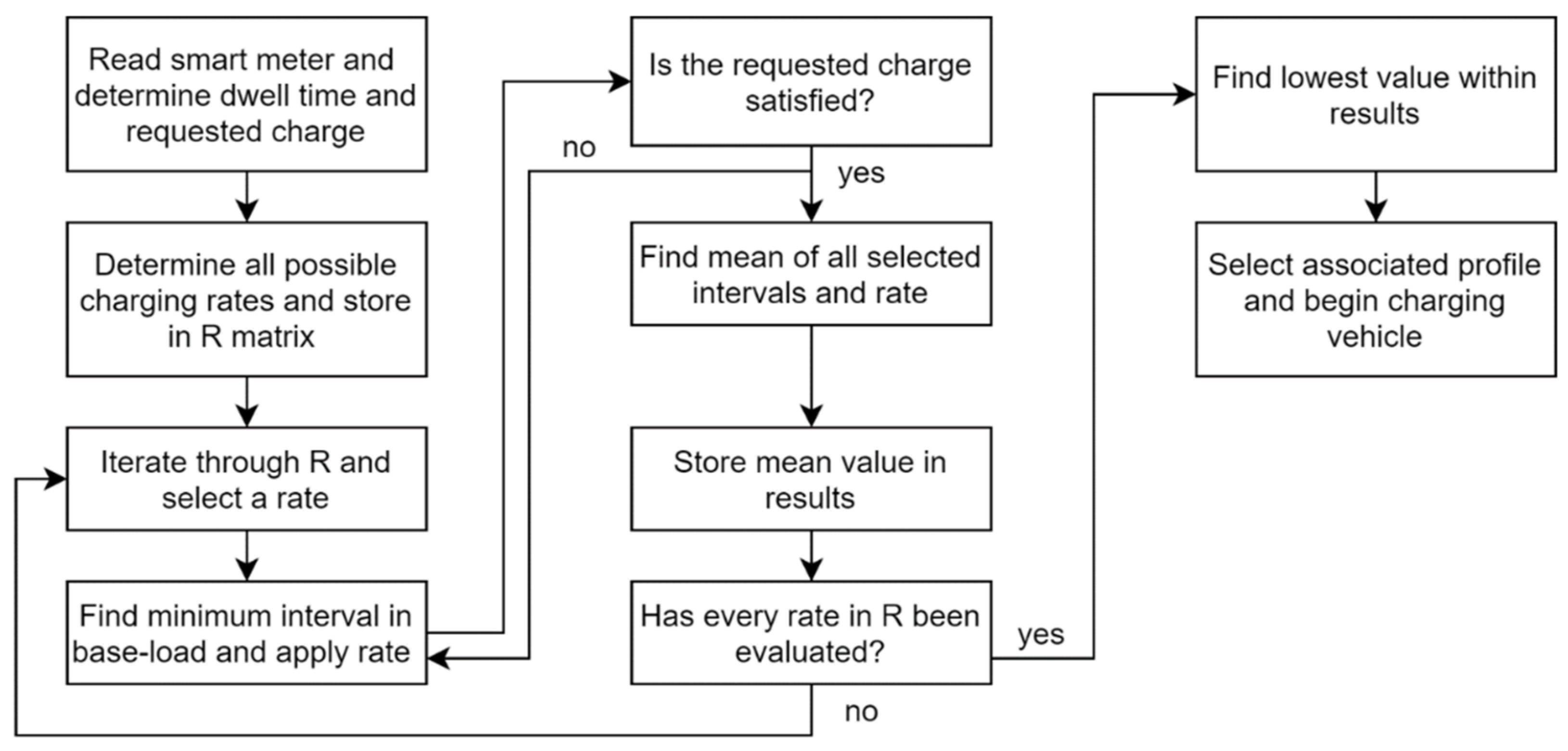
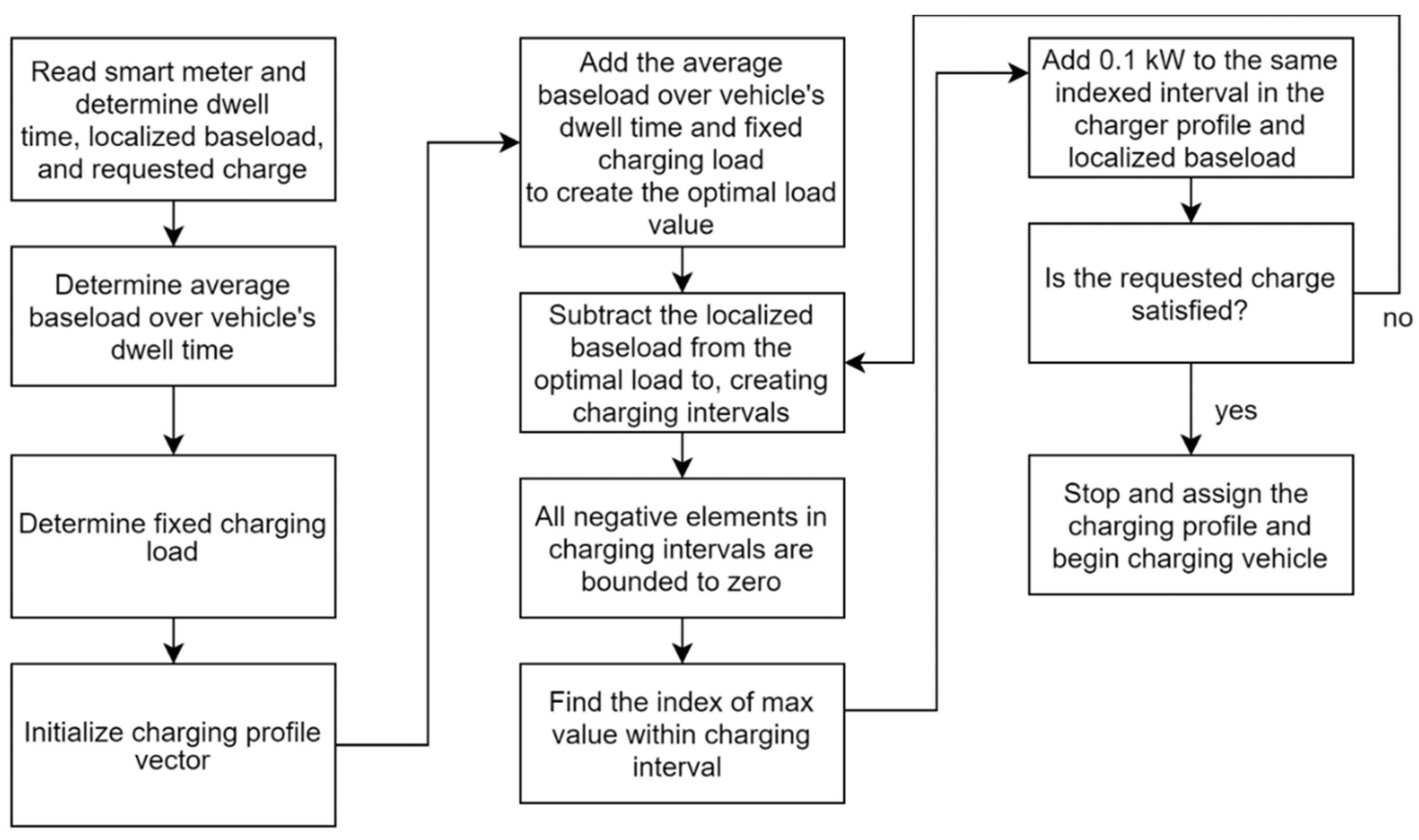
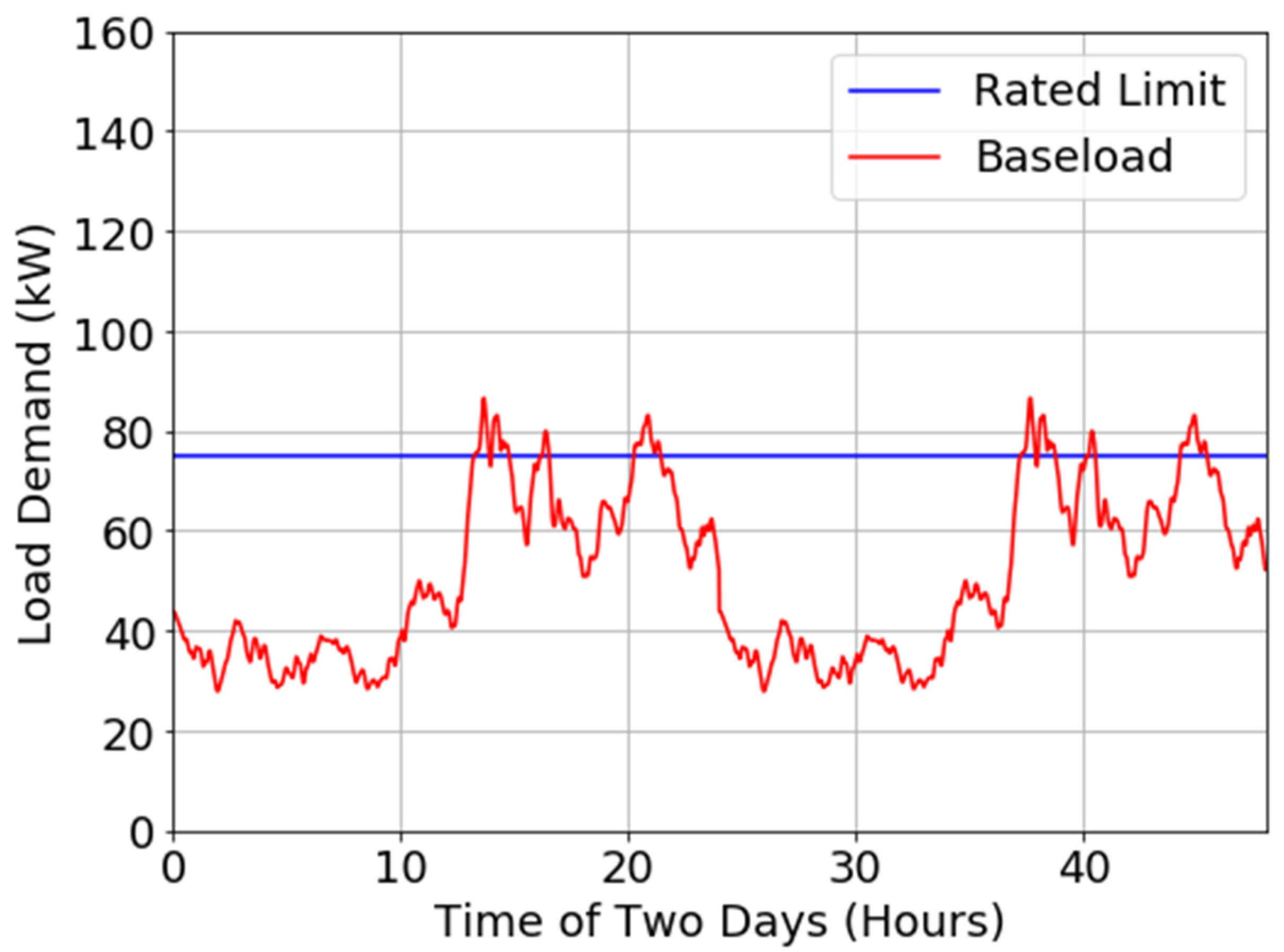
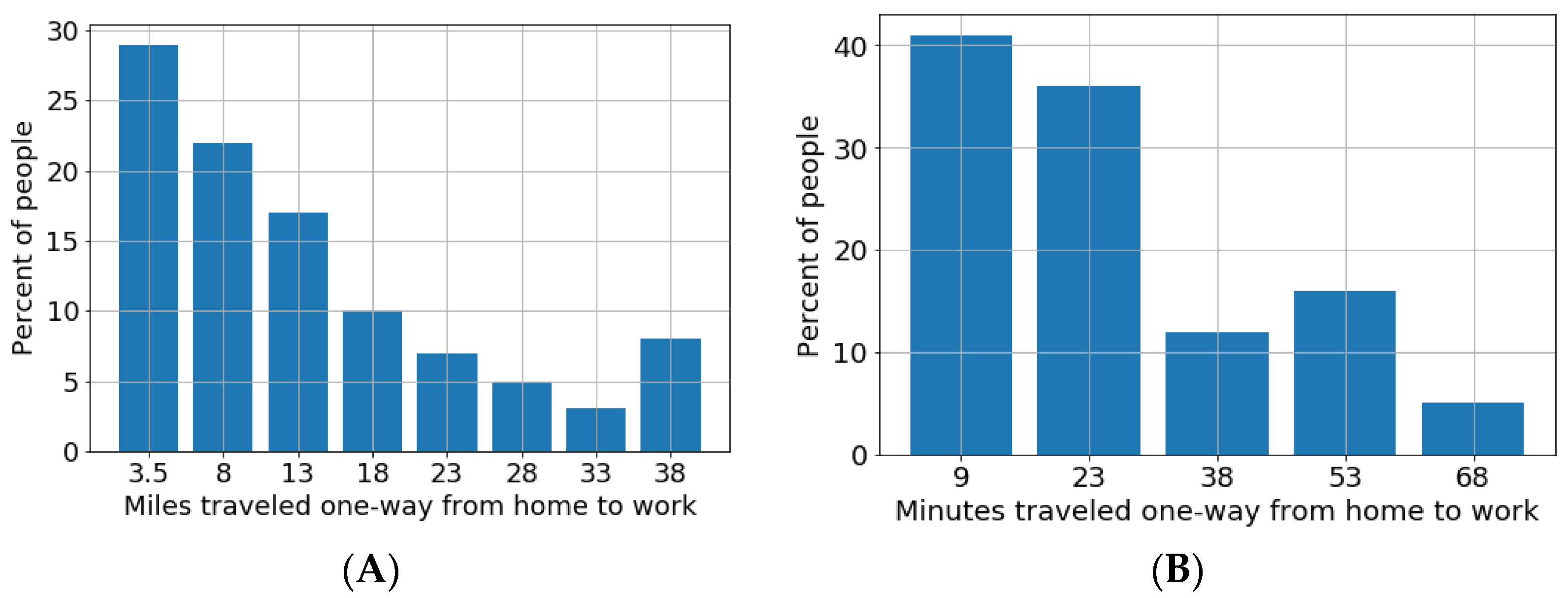
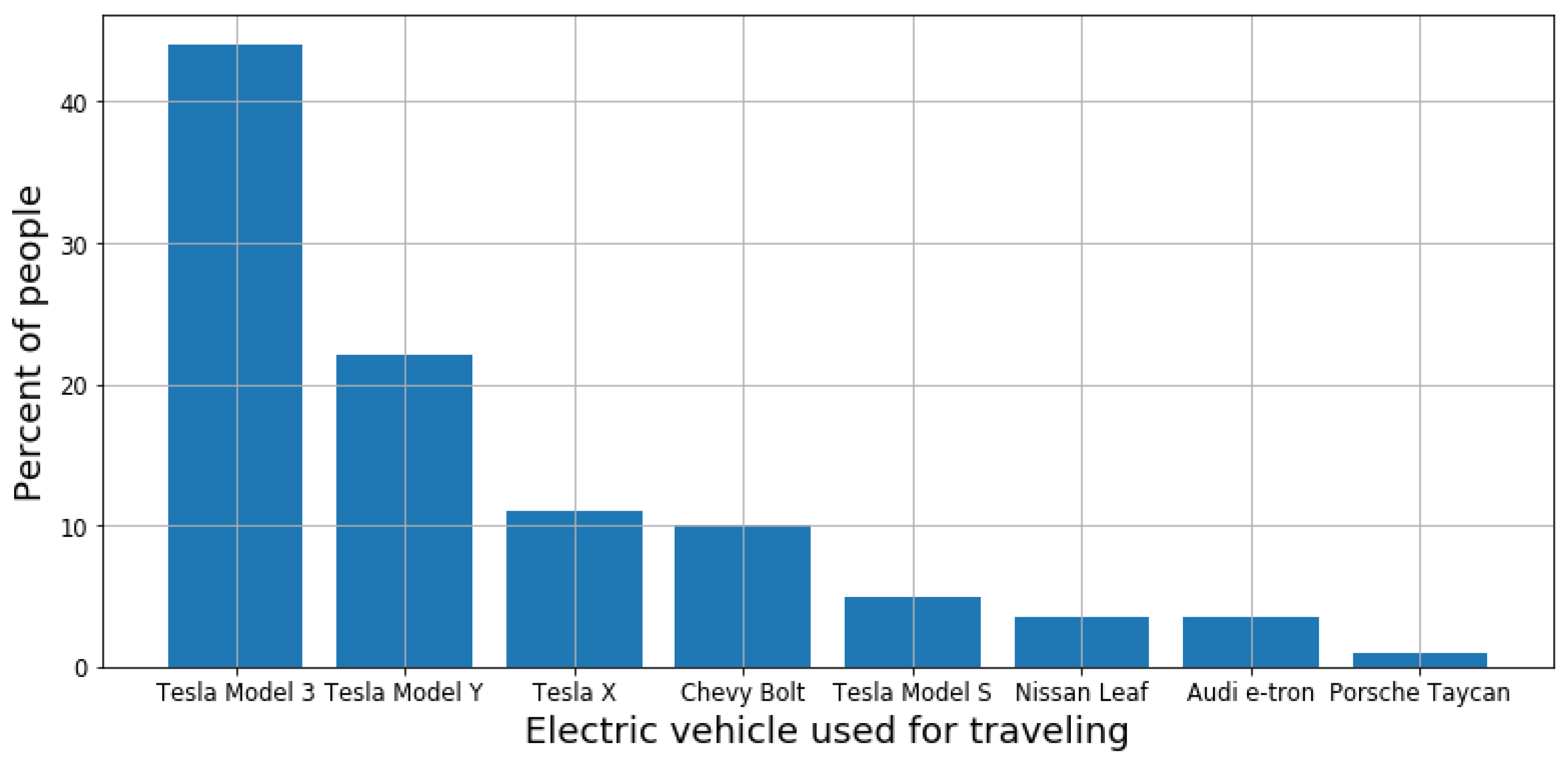
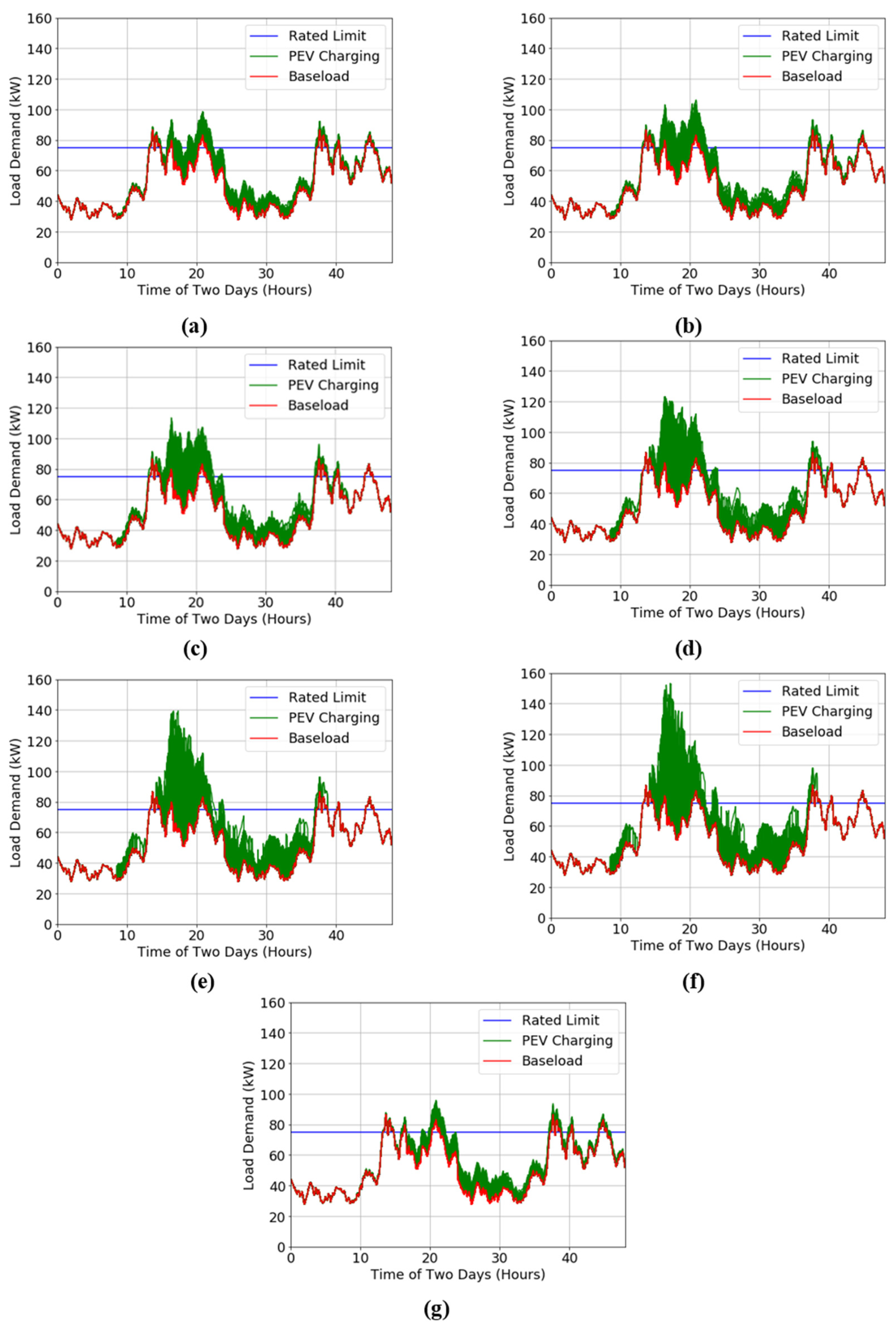
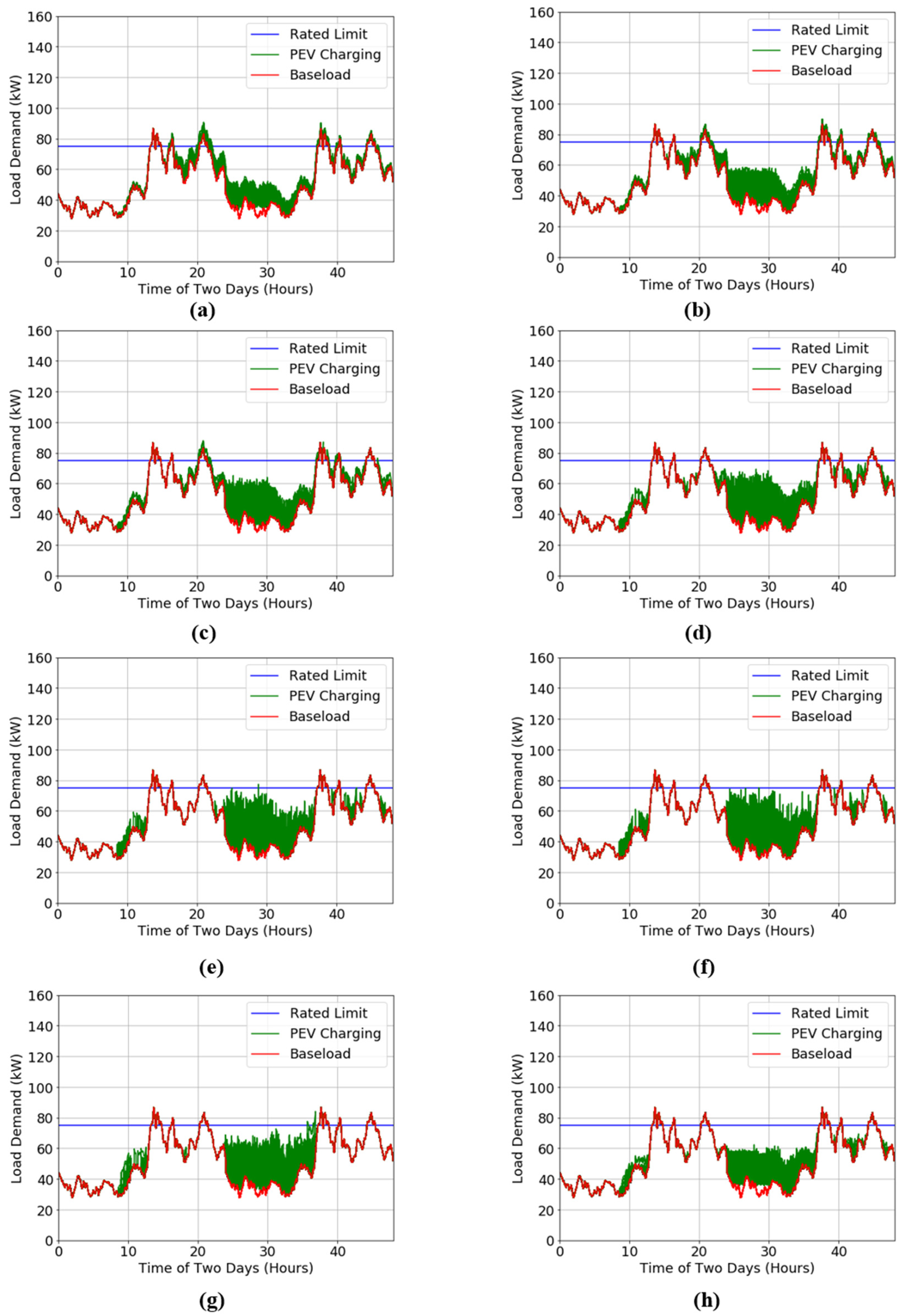
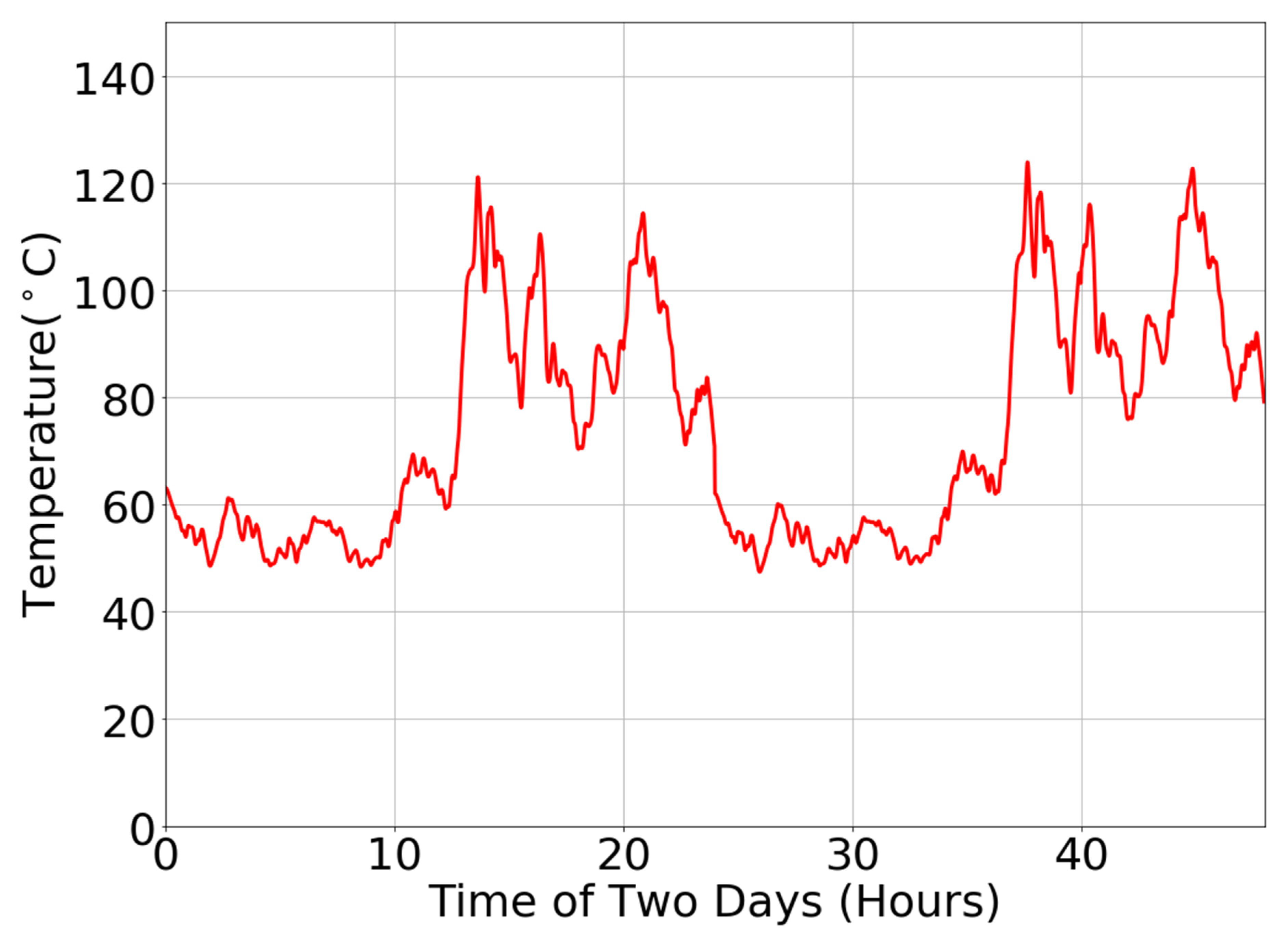
| Schedule | Percentage | Mean Start Time | Time Duration |
|---|---|---|---|
| Day | 84% | 7:30 a.m. | 8 h |
| Evening | 6% | 3:30 p.m. | 8 h |
| Night | 4% | 11:30 p.m. | 8 h |
| Day Shift | 3% | 5:00 a.m. | 12 h |
| Night Shift | 3% | 5:00 p.m. | 12 h |
| Activity | Engaged Population | Added Time to Commute | Added Distance to Commute |
|---|---|---|---|
| Caring for and helping household members | 14.6% | 30 min | 3 miles |
| Leisure and sports | 28.7% | 1 h | 3 miles |
| Purchasing goods and services | 40.8% | 30 min | 3 miles |
| Eating and drinking | 19.5% | 1 h | 3 miles |
| Personal care | 3.4% | 1 h | 3 miles |
| Vehicle Model | kWh/100 miles |
|---|---|
| Tesla Model 3 | 26 |
| Tesla Model Y | 28 |
| Tesla Model X | 33 |
| Chevy Bolt | 29 |
| Tesla Model S | 31 |
| Nissan Leaf | 30 |
| Audi e-tron | 44 |
| Porsche Taycan | 49 |
| Case # | Case Type | Absolute Maximum Peak (kW) | Average Maximum Peak (kW) | Average Load during Charging (kW) |
|---|---|---|---|---|
| 1 | Uncontrolled 1.9 kW | 98.33 | 90.92 | 59.02 |
| 2 | Uncontrolled 3.3 kW | 106.23 | 92.17 | 65.91 |
| 3 | Uncontrolled 4.8 kW | 113.48 | 94.34 | 69.79 |
| 4 | Uncontrolled 7.2 kW | 123.18 | 99.33 | 73.03 |
| 5 | Uncontrolled 9.6 kW | 139.33 | 104.93 | 75.67 |
| 6 | Uncontrolled 11.5 kW | 153.14 | 109.11 | 77.73 |
| 7 | Uncontrolled 0–11.5 kW | 95.84 | 88.95 | 55.70 |
| Case # | Case Type | Absolute Maximum Peak (kW) | Average Maximum Peak (kW) | Average Load during Charging (kW) |
|---|---|---|---|---|
| 8 | Controlled 1.9 kW | 90.73 | 87.73 | 49.15 |
| 9 | Controlled 3.3 kW | 89.88 | 86.60 | 45.11 |
| 10 | Controlled 4.8 kW | 87.93 | 86.58 | 44.55 |
| 11 | Controlled 7.2 kW | 86.58 | 86.58 | 44.99 |
| 12 | Controlled 9.6 kW | 86.58 | 86.58 | 45.85 |
| 13 | Controlled 11.5 kW | 86.58 | 86.58 | 46.77 |
| 14 | SRVF | 86.58 | 86.58 | 44.41 |
| 15 | RIVF | 86.58 | 86.58 | 44.02 |
| Case # | Case Type | <50% | 50–59.9% | 60–69.9% | 70–79.9% | 80–89.9% | >90% |
|---|---|---|---|---|---|---|---|
| 1 | Uncontrolled 1.9 kW | 8 | 33 | 93 | 129 | 237 | 21,989 |
| 2 | Uncontrolled 3.3 kW | 0 | 0 | 2 | 4 | 3 | 22,491 |
| 3 | Uncontrolled 4.8 kW | 0 | 0 | 0 | 0 | 0 | 22,500 |
| 4 | Uncontrolled 7.2 kW | 0 | 0 | 0 | 0 | 0 | 22,500 |
| 5 | Uncontrolled 9.6 kW | 0 | 0 | 0 | 0 | 0 | 22,500 |
| 6 | Uncontrolled 11.5 kW | 0 | 0 | 0 | 0 | 0 | 22,500 |
| 7 | Uncontrolled 0–11.5 kW | 0 | 0 | 0 | 0 | 0 | 22,500 |
| 8 | Controlled 1.9 kW | 8 | 33 | 93 | 129 | 237 | 21,989 |
| 9 | Controlled 3.3 kW | 0 | 0 | 2 | 4 | 3 | 22,491 |
| 10 | Controlled 4.8 kW | 0 | 0 | 0 | 0 | 0 | 22,500 |
| 11 | Controlled 7.2 kW | 0 | 0 | 0 | 0 | 0 | 22,500 |
| 12 | Controlled 9.6 kW | 0 | 0 | 0 | 0 | 0 | 22,500 |
| 13 | Controlled 11.5 kW | 0 | 0 | 0 | 0 | 0 | 22,500 |
| 14 | SRVF | 0 | 0 | 0 | 0 | 0 | 22,490 |
| 15 | RIVF | 0 | 0 | 0 | 0 | 0 | 22,490 |
| Case | Uncontrolled 4.8 kW | Uncontrolled 7.2 kW | Uncontrolled 9.6 kW | Uncontrolled 11.5 kW | Uncontrolled 0–11.5 kW |
|---|---|---|---|---|---|
| Uncontrolled 0–11.5 kW | 20.19% | 23.73% | 26.39% | 28.34% | - |
| Controlled 4.8 kW | 36.17% | 39.00% | 41.13% | 42.69% | 20.08% |
| Controlled 7.2 kW | 35.54% | 38.40% | 40.54% | 42.12% | 19.29% |
| Controlled 9.6 kW | 34.30% | 37.22% | 39.41% | 41.01% | 17.74% |
| Controlled 11.5 kW | 32.98% | 35.96% | 38.19% | 39.83% | 16.09% |
| SRVF | 36.37% | 39.19% | 41.31% | 42.87% | 20.30% |
| RIVF | 36.93% | 39.72% | 41.83% | 43.37% | 21.03% |
| Figure | Limit |
|---|---|
| Oil temperature | 120 °C |
| Winding hot spot temperature | 200 °C |
| Short time loading (30 min or less) | 300% |
| Case # | Case Type | Number of Transformers Exceeding HST of 140 °C | Number of Transformers Exceeding HST of 200 °C |
|---|---|---|---|
| 1 | Uncontrolled 1.9 kW | 14 | 0 |
| 2 | Uncontrolled 3.3 kW | 162 | 0 |
| 3 | Uncontrolled 4.8 kW | 500 | 0 |
| 4 | Uncontrolled 7.2 kW | 1409 | 0 |
| 5 | Uncontrolled 9.6 kW | 2016 | 27 |
| 6 | Uncontrolled 11.5 kW | 2201 | 120 |
| 7 | Uncontrolled 0–11.5 kW | 0 | 0 |
| 8 | Controlled 1.9 kW | 0 | 0 |
| 9 | Controlled 3.3 kW | 0 | 0 |
| 10 | Controlled 4.8 kW | 0 | 0 |
| 11 | Controlled 7.2 kW | 0 | 0 |
| 12 | Controlled 9.6 kW | 0 | 0 |
| 13 | Controlled 11.5 kW | 0 | 0 |
| 14 | SRVF | 0 | 0 |
| 15 | RIVF | 0 | 0 |
| Charging Profile | EAF | LOL% | ||||
|---|---|---|---|---|---|---|
| Min | Avg | Max | Min | Avg | Max | |
| Uncontrolled 1.9 kW | 0.05255 | 0.07478 | 0.12291 | 7.006 × 10−4 | 9.971 × 10−4 | 1.639 × 10−3 |
| Uncontrolled 3.3 kW | 0.05367 | 0.08457 | 0.26752 | 7.156 × 10−4 | 1.128 × 10−3 | 3.567 × 10−3 |
| Uncontrolled 4.8 kW | 0.05366 | 0.09718 | 0.35074 | 7.155 × 10−4 | 1.296 × 10−3 | 4.676 × 10−3 |
| Uncontrolled 7.2 kW | 0.05344 | 0.14026 | 1.29541 | 7.125 × 10−4 | 1.870 × 10−3 | 1.727 × 10−2 |
| Uncontrolled 9.6 kW | 0.05362 | 0.26847 | 10.38318 | 7.149 × 10−4 | 3.580 × 10−3 | 1.384 × 10−1 |
| Uncontrolled 11.5 kW | 0.05407 | 0.53037 | 46.26239 | 7.209 × 10−4 | 7.072 × 10−3 | 6.168 × 10−1 |
| Uncontrolled 0–11.5 kW | 0.05510 | 0.06483 | 0.09434 | 7.347 × 10−4 | 8.645 × 10−4 | 1.258 × 10−3 |
| Controlled 1.9 kW | 0.05149 | 0.05358 | 0.06828 | 6.866 × 10−4 | 7.144 × 10−4 | 9.104 × 10−4 |
| Controlled 3.3 kW | 0.05149 | 0.05190 | 0.06261 | 6.866 × 10−4 | 6.921 × 10−4 | 8.348 × 10−4 |
| Controlled 4.8 kW | 0.05150 | 0.05169 | 0.05905 | 6.866 × 10−4 | 6.891 × 10−4 | 7.873 × 10−4 |
| Controlled 7.2 kW | 0.05150 | 0.05166 | 0.05441 | 6.867 × 10−4 | 6.888 × 10−4 | 7.254 × 10−4 |
| Controlled 9.6 kW | 0.05151 | 0.05168 | 0.05402 | 6.867 × 10−4 | 6.890 × 10−4 | 7.203 × 10−4 |
| Controlled 11.5 kW | 0.05151 | 0.05169 | 0.05378 | 6.868 × 10−4 | 6.893 × 10−4 | 7.171 × 10−4 |
| RIVF | 0.05149 | 0.05163 | 0.05323 | 6.866 × 10−4 | 6.884 × 10−4 | 7.097 × 10−4 |
| SRVF | 0.05149 | 0.05164 | 0.05471 | 6.866 × 10−4 | 6.884 × 10−4 | 7.294 × 10−4 |
Publisher’s Note: MDPI stays neutral with regard to jurisdictional claims in published maps and institutional affiliations. |
© 2022 by the authors. Licensee MDPI, Basel, Switzerland. This article is an open access article distributed under the terms and conditions of the Creative Commons Attribution (CC BY) license (https://creativecommons.org/licenses/by/4.0/).
Share and Cite
Smith, T.; Garcia, J.; Washington, G. Novel PEV Charging Approaches for Extending Transformer Life. Energies 2022, 15, 4454. https://doi.org/10.3390/en15124454
Smith T, Garcia J, Washington G. Novel PEV Charging Approaches for Extending Transformer Life. Energies. 2022; 15(12):4454. https://doi.org/10.3390/en15124454
Chicago/Turabian StyleSmith, Theron, Joseph Garcia, and Gregory Washington. 2022. "Novel PEV Charging Approaches for Extending Transformer Life" Energies 15, no. 12: 4454. https://doi.org/10.3390/en15124454
APA StyleSmith, T., Garcia, J., & Washington, G. (2022). Novel PEV Charging Approaches for Extending Transformer Life. Energies, 15(12), 4454. https://doi.org/10.3390/en15124454






